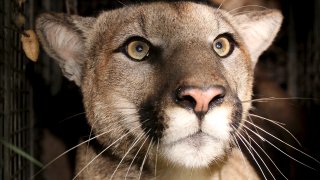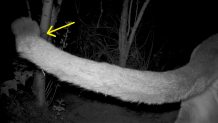
Inbreeding has long been identified as a major threat to the survival of mountain lions living in the isolated habitat of the Santa Monica Mountains, and biologists said on Wednesday that they have spotted the first physical abnormalities to develop in lions as a result of the limited genetic diversity.
"This is something we hoped to never see," wildlife biologist Jeff Sikich said. "We knew that genetic diversity was low here, but this is the first time we have actually seen physical evidence of it. This grave discovery underscores the need for measures to better support this population."
The physical manifestations were spotted in March in a young lion dubbed P-81, which has a kinked tail and only one descended testicle, according to the National Park Service, which has been studying the mountain lion population in the Santa Monica Mountains for nearly two decades.

Another lion with a kinked tail was spotted on camera in the same area just days later, and researchers believe it could be a sibling of P-81. A third lion believed to have a kinked tail was also spotted in the eastern portion of the mountains.
Researchers say the abnormalities are linked to "inbreeding depression," highlighting the danger facing the lions in the mountain range. A 2016 study prepared in conjunction with UCLA biologists predicted a nearly 100% chance that the lions will be extinct in the range within 50 years due to lack of genetic diversity.
"Along with a similarly isolated population in the Santa Ana Mountains south of L.A., we have seen the lowest levels of genetic diversity ever documented in the West," said Seth Riley, wildlife branch chief for Santa Monica Mountains National Recreation Area and an adjunct professor at UCLA. "The only population with lower levels was in south Florida a couple of decades ago, when Florida panthers were on their way to extinction. The really interesting, and worrying, thing is that they saw the same type of kinked tails and cryptorchidism there."
Local
Get Los Angeles's latest local news on crime, entertainment, weather, schools, COVID, cost of living and more. Here's your go-to source for today's LA news.
Cryptorchidism is when one or both testes fail to descend, leaving the animal unable to reproduce, according to the NPS.
In the case of the Florida panthers, which appeared bound for extinction due to the inbreeding, researchers imported eight female lions from Texas to widen the genetic diversity of the population. There are now about 200 mountain lions in that population, up from a low of 20-30, according to the NPS.
Riley said the discovery of the physical abnormalities in the Santa Monica Mountains lions highlights the need to open up the genetic diversity in the range, most urgently through the construction of a planned wildlife crossing over the 101 Freeway in the Liberty Canyon area, which will connect wildlife populations from both sides of the highway.
"The truth is that we want to build that connectivity not just for the mountain lions, but for all of the wildlife," Riley said.



